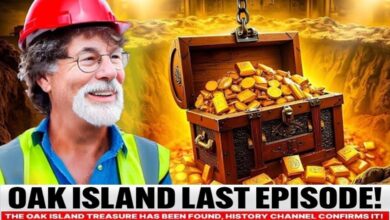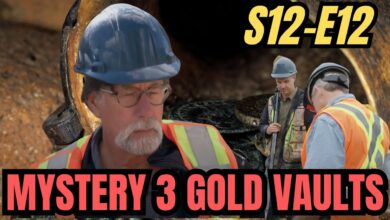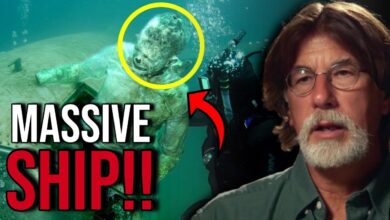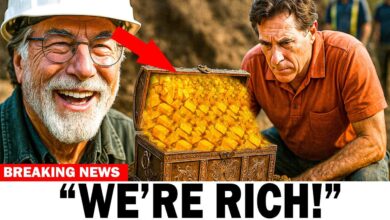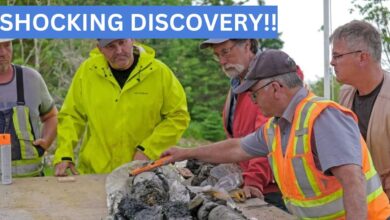Top Discoveries Linked to Samuel Ball | The Curse of Oak Island
Top Discoveries Linked to Samuel Ball | The Curse of Oak Island

MARTY LAGINA: Let’s go find something good, Gary. Yep. [beeping] Oh, that sounds nice. Yeah, and it is just here to the side of the tree.
MARTY LAGINA: Yeah. [beeping]
GARY DRAYTON: You might have got it out. [beeping]
Yeah, you have. See what we’ve got. It’s in my hand. Ooh, look at that. We are looking at a little pocket knife.
Seriously?
Yeah.
NARRATOR: On Lot 25, near the foundation of the house that once belonged to Samuel Ball, metal detection expert Gary Drayton and Marty Lagina have just found what could be an important discovery.
MARTY LAGINA: I’d say that’s copper or something.
GARY DRAYTON: Yeah, the ends are copper. That’s why we detected it.
MARTY LAGINA: They don’t make them out of that anymore, do they?
GARY DRAYTON: Not so much.
Yeah, it looks like half of a pocket knife.
Yeah. And the blade must still be in there.
MARTY LAGINA: That looks like a fine gentleman’s pocket knife. So, you know, we’re hoping that it’s valuable. And I think Samuel Ball was just a highly successful man, and he may have had some things we’re unaware of.
GARY DRAYTON: Well, we’ll see what it looks like when it’s cleaned up. –cleaned up.
Nice little find. Well, this is a great start.
It really is.
MARTY LAGINA: It’s an excellent start.
Yeah, let’s keep going. I’m excited.
-
Yeah.
MARTY LAGINA: Let’s go find some more stuff.
GARY DRAYTON: Yeah. [beeping]
Oh, not so good.
Yeah, that didn’t sound as good to me.
GARY DRAYTON: No. [beeping]
MARTY LAGINA: That sounds good to me. That sounds good.
Just there. Here we go. [beeping]
Oh, I’m on it.
You’re on it. [beeping]
I feel something, though.
Ooh, yeah, that’s nice. What is it?
A badge?
No, it’s not a badge, mate.
Yeah. To me, that looks like musket decoration.
Oh, like you found with Samuel Ball at?
GARY DRAYTON: Yeah.
That might clean up and have some kind of design on it, or some letters or numbers.
MARTY LAGINA: For sure, it has letters on it.
GARY DRAYTON: Yes? -
Oh, yeah. I was hoping.
It says, patent.
GARY DRAYTON: It says patent.
MARTY LAGINA: Mhm. Now you can see it.
Oh, yeah. Look at that. That’s nice, isn’t it?
There ain’t any doubt about that.
NARRATOR: A patent plate possibly from an old rifle or musket? During the 17th and 18th centuries, as firearm technology advanced in Europe and colonial North America, manufacturers placed engraved patent plates on their muskets as a way of protecting the ownership of any unique innovations, such as the firing mechanism or the weapon’s design.
Similar to a maker’s mark, a patent plate could help reveal when and where an artifact was made, as well as possibly identify who it once belonged to.
What do you think, Gary? How old is that?
GARY DRAYTON: With that design, the way it’s got that nice old-style lettering, I’d say that’s period, mate, for this lot. 1790, 1830, Samuel Ball era.
Yeah, I think it’s period.
GARY DRAYTON: Yeah.
MARTY LAGINA: I’d bet a lot that was on a firearm.
GARY DRAYTON: Yeah, it could have easily been on the stock or the bolt. Maybe that’s the way I look for whatever this is.
MARTY LAGINA: That’s what I would do. [inaudible] I would start with guns, probably British armaments.
GARY DRAYTON: Yeah.
MARTY LAGINA: I mean, if you find out that that was some kind of a nice shooting firearm, it might speak to wealth.
Yeah.
MARTY LAGINA: The little patent thing was really exciting, because I view it as yet another indication that Samuel Ball had a fair amount of wealth.
Gary, partner, let’s put it in the bag and we’ll go on to hopefully bigger and better things.
Yeah. And we’ll tell [inaudible] about this.
MARTY LAGINA: Cheers, mate.
GARY DRAYTON: We found some cool stuff.
MARTY LAGINA: Yeah.
GARY DRAYTON: Here we are, mate.
NARRATOR: Over on lot 26–
GARY DRAYTON: This used to be owned by Samuel Ball, and it was farmland back in the day.
NARRATOR: –metal detection expert Gary Drayton, along with treasure hunter Michael John, are investigating an area near the foundation that once belonged to Samuel Ball. They are hoping to find more clues as to why the 19th century Oak Island landowner mysteriously came to be one of the wealthiest men in the province of Nova Scotia.
What I’ve done– since we have cleared out the surface artifacts, I brought the big mama jamma.
There you go. It’s a little bit of the bigger coil.
Yes. [laughter]
What’s the maximum depth for this one? Like, a cannon ball-sized target, about six, seven feet.
Oh, yeah?
Wow.
This area is now cleared of trees and shrubs and bulrushes. Gives me an opportunity to run the GPX 5000 with a 32-inch coil. We’re looking for deep targets.
Look at that. Is this a good little clearing to start?
Yeah. I want to go in these wide open spaces. Hopefully, we find something.
OK, we’re ready to rock and roll.
All righty.
MARTY LAGINA: Other than the interest in Samuel Ball, the human being, there is a little bit of a glimmer that he was a little bit more than meets the eye.
I don’t think there’s any way anybody that smart, that aware of things, wouldn’t have known exactly what was going on Oak Island the whole time he was there. The more I can find out about this person, the better.
That was a small piece of iron.
Small piece? Yup. [humming]
Come on. Where are you? [beeping]
Oh. [laughs] Look at that. Very strong signal. [beeping]
Looks like it’s just here, mate.
OK. [music playing]
OK?
Yep. See, I should be able to hit it. That should be something good. It’s deep, so it should be old.
Cool. What we got here?
That’s it. That’s probably it, yes.
Yeah. That is a little baby ox shoe.
We found the Shaq daddy, the mother of all ox shoes near the swamp. And now we found a little baby one.
That is a small little ox shoe.
Now, we’ve pulled up several different ox shoes in really good condition. And if there’s some kind of industrial operation, you’re going to need beast of burden to transport whatever you was doing there.
And when we show these to Carmen, hopefully, Carmen will give us a country of origin.
It is an oldie. This is an old artifact. I’ve just never seen them this small.
What a nice little artifact. And I’m looking forward to taking this to Carmen Legge to–
MICHAEL JOHN: Oh, yeah.
–to give us a story behind this.
Hey, great find, Michael.
MICHAEL JOHN: That’s right.
GARY DRAYTON: Great find. We got to tell the archeologists about this area.
MICHAEL JOHN: That’s right, yeah.
ALEX LAGINA: I brought a trowel in case you need some help.
Oh, excellent. We can always use help.
NARRATOR: Marty Lagina’s son Alex arrives at the foundation of late 18th century Oak Island landowner Samuel Ball.
We’ve got the cellar all cleaned out. Just some final, you know, getting rid of dirt and excavating in there. It looks good.
NARRATOR: It is here where archaeologists Laird Niven and Liz Michaels continue their meticulous investigation for clues that might help explain how Mr. Ball, a simple cabbage farmer and former American slave, mysteriously became a very wealthy man by the early 19th century.
Piece of pottery here.
Oh, you should find lots.
I see why you needed somebody to sift.
Yeah, it’s– I think I’ll be here all day. It slows things down.
That’s true.
MARTY LAGINA: I’m impressed with the patience these archaeologists have to unearth all of that with a trowel.
I’m very interested in what’s going on in the Ball foundation. They’ve been digging over there for quite some time, and I want to see it.
There you are. Thank you.
Hey, look at this. I got a coin. I think.
It’s got–
Oh, yeah, yeah, yeah, yeah.
A little green.
LAIRD NIVEN: Yep.
Yeah, this looks old. It’s got kind of irregular edges, like a flat portion.
It does look like the design is a little off-center.
Well, I’ll entrust it to you.
Well, it’s heavy enough.
ALEX LAGINA: When I first picked it out, I thought I could see a pattern. And it seemed off-center to me.
Oh, I see what you mean.
Part of the reason we’re doing all this work on the Ball foundation is to investigate the possibility that Samuel Ball had a closer involvement with the Money Pit than what was previously known.
So if we can date this coin to the same time period as these other finds we’re making, that’s it. That’s our connection.
I see what you mean about the edges.
Mm-hmm.
Yeah.
I think we’ll bag it, get it to the research center, and see what we can see.
Mm-hmm. I’ll just– I’ll find a few more for you.
OK, thank you.
NARRATOR: Later that afternoon.
Hey, guys.
Hey.
Hey. Take a look at this.
Whoa.
NARRATOR: Alex Lagina and Laird Niven have gathered in the research center with Rick, David, and Gary Drayton to share their new discovery.
So this just came off of the Ball property.
Oh.
ALEX LAGINA: I found it sifting through some of the stuff that– the most recent test bed that Laird’s been doing, right by the edge of the house.
Yeah, the northwest corner. Uh-huh.
ALEX LAGINA: So if you look, you see the anchor on the right.
RICK LAGINA: Yeah.
DAVID FORNETTI: Right.
So is the middle an anchor, or is it a cross?
If you pull it down to show the edge–
GARY DRAYTON: It’ll be a larger anchor.
ALEX LAGINA: Well, there you can see the indents.
GARY DRAYTON: Yep. There’s three anchors. There’s one on the right, there’s a large one in the middle, and then there’s one on the left.
LAIRD NIVEN: Down the side there.
DAVID FORNETTI: Oh, yeah.
ALEX LAGINA: And then see the other one on the left there?
Yeah, it looks like little waves, and I can see a rope design around the outside of it.
I know what that is. It’s a Navy jacket button.
If it’s got anchors on it and a rope designed around it, without a doubt, that is a British Navy jacket button.
ALEX LAGINA: What time period is this, though?
1804 to 1825, solidly within the Ball period.
We’ve been searching and searching for some military connection with Samuel Ball because we know he served the British during the Revolutionary War, which is how he gained his freedom and came to Nova Scotia, so.
I think you just made that connection.
ALEX LAGINA: Yeah. It’s one of the nicest buttons we found in terms of legibility.
RICK LAGINA: Yeah, the front is spectacular. I mean, those anchors are amazing.
I look forward to seeing how much information we can get off of this.
Yeah. It’s a beautiful piece.
ALEX LAGINA: Oh, yeah.
RICK LAGINA: Whether there’s more information or not, it’s stunning.
ALEX LAGINA: Cool. I think that is gold or gilding right there.
ALEX LAGINA: I think so.
LAIRD NIVEN: That would make sense.
GARY DRAYTON: Yeah. That would point to officer, though, wouldn’t it?
Yeah. Normally, the officers had the gilded buttons.
Yeah.
NARRATOR: An officer’s button? If so, why did a high-ranking British Naval officer visit the home of Samuel Ball on Oak Island? And could it have something to do with the mysterious wealth Ball came to possess?
MARTY LAGINA: It’s a Royal Navy button.
Apparently, it would be somebody on a ship of some import, an important person.
What’s that doing in Samuel Ball’s foundation?
I mean, we’re talking about an officer being in his house. That’s kind of a big deal, I think. -
OK.
-
All right. Thank you.
Thanks for calling.
We will keep you posted.
Thank you.
All right, man.
ALEX LAGINA: All right. See you later, guys. [music playing]
GARY DRAYTON: That is cool.
CHARLES BARKHOUSE: That is very cool.
GARY DRAYTON: This is somebody’s signature. This is somebody’s name.
NARRATOR: While searching for artifacts on lot 24, the area once owned in the early 1800s by Oak Island Resident Samuel Ball, metal detection expert Gary Drayton, along with Oak Island historian Charles Barkhouse, have just made a number of incredible and potentially significant discoveries.
GARY DRAYTON: So we’ve got six coins, a fancy button. And you look at that rivet and the way that’s curved, that could have been on the end of a pistol.
Based on your experience, are you willing to say that this could be a camp?
Yeah, some kind of encampment.
That’s amazing.
NARRATOR: An encampment? Could Charles and Gary be looking at evidence that the stories about stolen Spanish gold are true? If so, could the treasure still be hidden somewhere on the island?
Hey, Marty?
MARTY LAGINA: Yeah?
Over here.
What do you guys got?
Tell him what you think we found.
Lay it on me. What have you got?
Some good news.
Good news?
Roundness?
Roundness.
Yep.
Holy smokes.
Look at these.
Wow.
All in one spot?
GARY DRAYTON: See that guy there?
MARTY LAGINA: Yeah?
GARY DRAYTON: See? King George II.
What is that date from?
Early 1700s.
No kidding.
These are all British coppers.
All in one spot?
[interposing voices]
Yeah, we’ve got six of them in this circle.
Small little radius here.
And this?
Belt buckle?
That has got script.
No, I think this is off of the end of a pistol.
Do you see the writing on there, the script writing?
Oh, yeah, yeah, yeah, yeah.
That could be the person’s name who owned the pistol.
[interposing voices]
Oh, yeah, yeah, yeah, yeah.
All of these, right here?
Yeah.
I just think this– there’s so much stuff here.
I think this is an encampment or a camp.
Well, then we really could be onto something, right?
It’s very exciting.
We could be on some kind of encampment. And Gary feels it’s George II’s head on there. So if it’s George II, it predates the original finding of the money pit, so even more exciting.




